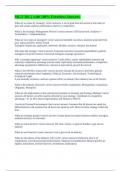MGT 301 || with 100% Errorless Answers.
What do we mean by Strategy? correct answers A set of goal-directed actions a firm takes to
gain and sustain superior performance relative to competitors.
What is the Strategic Management Process? correct answers AFI framework: Analysis-->
Formulation--> Implementation
What are two types of strategies? correct answers Intended: top-down, planned, projected from
past, rigid, proactive, timed, formal
Emergent: bottom-up, unplanned, unforseen, flexible, reactive, untimed, less formal
Who does the strategy? correct answers Corporate executives (overall responsibility), general
managers (run profit centers), functional managers (manage operatives)
Why is strategy important? correct answers 5 order effect: satisfy stakeholders (internal and
external), competitive advantage (can be easily replicated), increased performance, competitive
advantage (quantitative differences, reinvest in innovation), growth & survival
What is the PESTEL framework? correct answers Groups the factors in the firm's general
external environment into 6 segments: Political, Economic, Sociocultural, Technological,
Ecological, Legal.
Is not mutually exclusive, and has a greater effect on industry then industry has on the factors.
What is the Industry Structure? correct answers Perfect competition, Monopolistic competition,
Oligopoly, Monopoly
What are the implications of the external environment on Strategy and Strategy-Making? correct
answers All factors can affect and be affected by your strategy, contributes to competitive
advantage, "A" in AFI, shows Opportunities and Threats in SWOT.
Caveats to External Environment chart correct answers Assumes that all players are equal (no
differentiation), and assumes that all forces are equal as well. Does not show strategy within the
firm.
What are strategic groups? correct answers Groups based on similar business models, strategies,
products/services, or customers
What are entry barriers? correct answers The time, money, or general hurdles to get into an
industry
What are exit barriers? correct answers Cost to get out of an industry
What are the phases of the Industry Life Cycle? correct answers Embryonic (low # of
competitors), Growth (increased market share), Shakeout (consolidation), Mature (profits are
highest, innovation), Decline (harvest, divestitures, bankruptcy)
, What are core competencies? correct answers Unique strengths embedded deep within a firm,
and allow for differentiation.
Increase value and/or lower costs
Defined by V(aluable), R(are), I(costly to imitate), O(rganized to capture value of the resource)
How and Where do firms create and re-create core competencies? correct answers Develop
through the interplay of resources and capabilities (those tangible and intangible).
The two types of activities in a Value Chain correct answers Primary: add value directly (SCM,
MKT, Ops)
Secondary: indirect (R&D, HR, ACCT)
What is a Value Chain? correct answers Describes the internal activities a firm engages in when
transforming inputs into outputs.
What are the four building blocks to the CC's (and their caveat) ? correct answers Quality (high-
end cars), Efficiency (Walmart), Innovation (Apple), Customer Responsiveness (J&J)
*Not mutually exclusive
What are the 6 sustainability isolating mechanisms? correct answers Isolating mechanisms are
barriers to imitation that prevent rivals from competing away the advantage a firm may enjoy.
1. Dynamic Capabilities 2. Future Value 3. Path Dependance 4. Causal Ambiguity 5. Social
Complexity 6. Intangible Property Protection
What are dynamic capabilities? correct answers A firm's ability to reinvest, hone, and upgrade its
resources in its quest for competitive advantage. In other words, the ability to adapt the internal
resource base to a changing external environment.
What is future value? correct answers The ability to create FV in a resource, and to also have
better expectations of future resource value.
What is path dependence? correct answers A situation in which the options one faces in the
current situation are limited by decisions made in the past.
What is causal ambiguity? correct answers A situation in which the cause and effect of a
phenomenon are not readily apparent aka the ability to hide the cause and effect of one's
activity/success.
What is social complexity? correct answers A situation in which different social and business
systems interact with one another.
What is intellectual property protection? correct answers A critical intangible resource that can
provide a strong isolating mechanism/competitive advantage.




